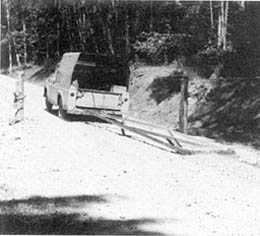On July 3, 1962, a dispute the press calls the Lester Gate War breaks out between King County and Tacoma. King County officials use a cutting torch and a pickup truck to remove a 500-pound gate closing a road leading to the small community of Lester. The Tacoma Water Department had placed the gate there to restrict access to the Green River watershed, source of much of Tacoma's water. The controversy will drag on for years, but Tacoma will ultimately close the area.
Since 1912, Tacoma drew water from the Green River, which ran through King County. Contamination from logging operations, agriculture, and human habitation threatened the water quality, so Tacoma sought to own or control a one-half mile "filter blanket" (Ott, 196) around the river and reservoir. Lester was a small community on the Northern Pacific Railroad within the watershed. One access route to the community was a road built by the St. Regis Paper Co. and later purchased by Tacoma.
Local residents, landowners, and outdoor enthusiasts resented Tacoma's actions and they battled land acquisitions and access agreements. King County Commissioner Ed Munro joined the fight by saying the road was a public right-of-way and ordered Lester Gate removed.
Seattle Post-Intelligencer "War Correspondent" William Schulze described the confrontation as follows:
"It was high noon and a broiling sun beat down on Green River Valley wilderness where two strong men stood face to face. King County Engineer Walter F. Winters and Vernon Meyer, a Tacoma sanitation engineer, looked each other squarely in the eye. King County and the City of Tacoma were at war ... Winters' raiders, who had invaded the Tacoma watershed, advanced into combat carrying an acetylene torch."
Tacoma responded the next day with a replacement chain and with guards. The case went to court, as did nearly every effort by the city to acquire control of the watershed. Eventually, Tacoma purchased Lester from the railroad, but allowed the residents to stay. The courts ruled in favor of the City's condemnation of private properties and Tacoma waited for the last Lester tenants to move on. By 1969, Tacoma owned nearly 10,000 acres of land around the Green River.

